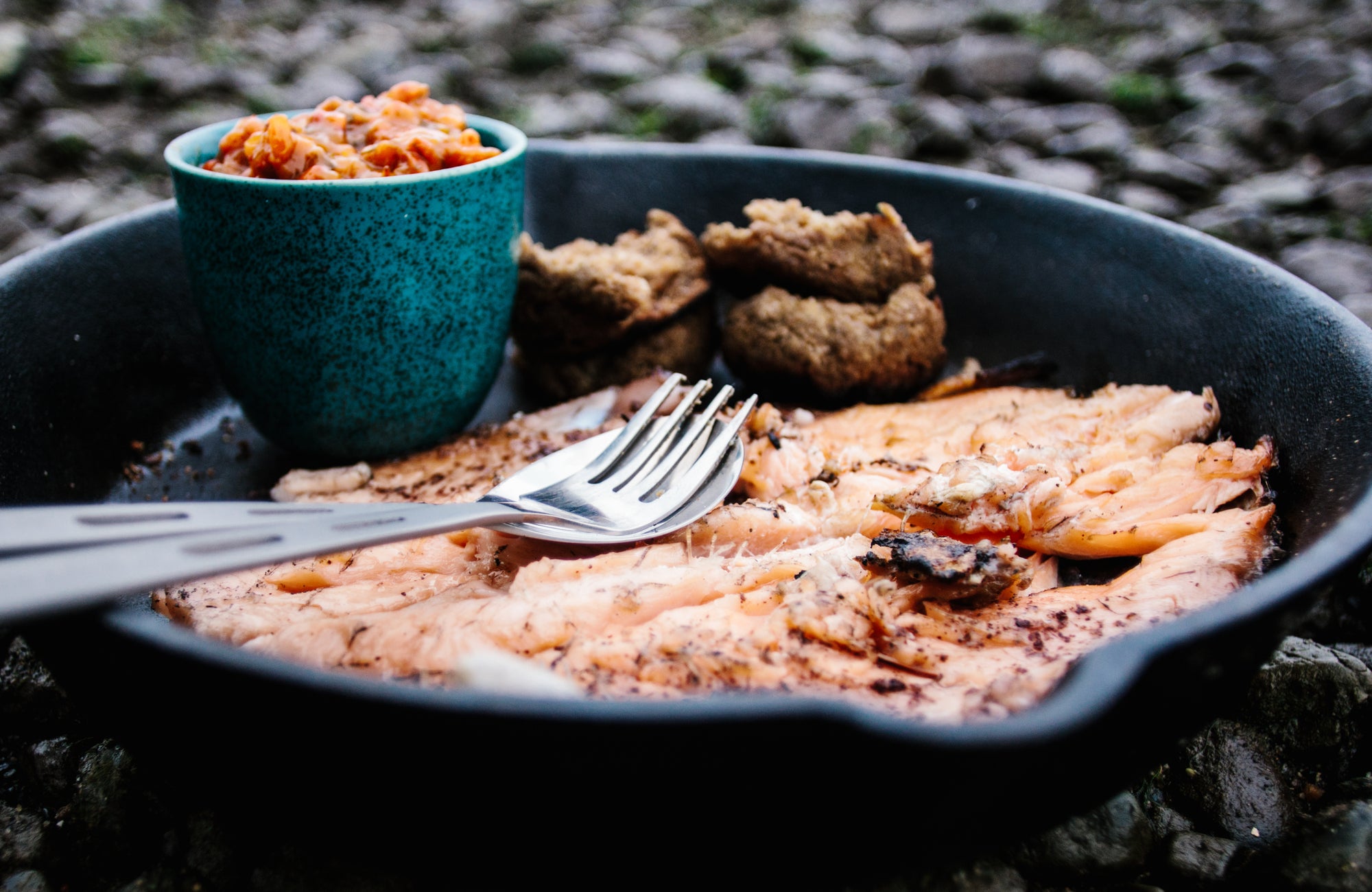Repost from Nordisk GO magazine 2015
For the last half hour there have been fleeting glimpses of sheltered coves and pebbled beaches, you’re very aware that your passengers are no longer listening to the radio, or you for that matter. Turning off the back roads onto a grass striped single lane track dusted with sand and there’s an instant sense of anticipation, a subtle yet important shift in the landscape and when you lower the window the tang of iodine and salt laden air.
That is usually all the incentive that’s needed for you and your friends to get out of the cars and start wandering, on the lookout for a vantage point from which you can set up camp and spot waves rolling in, surfers or sea kayakers, or to just revel in the fact that you’re outside again, all while hearing the crackle and smelling the wood smoke from your fire and eating food from the land and sea that surrounds you.
#1: Danish inspired Starter
Cured and hot smoked trout, sea buckthorn and herb jelly, rye griddle cakes
Talk about foraging and almost immediately, your mind conjures images of forests at twilight or fields and hedgerows in the sun, hunting for edible flowers, berries and mushrooms.
However, turn your gaze to the coast and you’ll be amazed at the abundance of wild edibles dotted along the ever shifting shoreline. Rock and marsh samphire, sea purslane, dilisk/dulsk, cockles, sea lettuce, kombu, sea spaghetti, mussels and the bright splash of orange berries, defended by wicked barbs that hopefully signify the presence of sea buckthorn.
Armed with knowledge, permission and a fishing rod, you can add fin fish to that trove. Slippery fish, just landed, cleaned and smoking over an open fire is an experience you would pay dearly for in many restaurants. Add in a secluded setting, your own hard work and the experience is without price.
 |
Ingredients
For 2 persons
2 Rainbow trout or 2 Arctic char fillets.
Cure
- 2 tbsp rough sea salt
- 2 tbsp sumac powder
- 1 tbsp sugar
Jelly
- 1 cup fresh or frozen sea buckthorn berries
- 1/2 cup water
- 1/2 - 1 cup caster sugar (depending on taste)
- Handful fresh lovage or sorrel leaves
- 1 tbsp agar agar flakes or 5g agar powder
Cakes
- 2 cups rye flour + 1/2 cup for dusting
- 2 tsp sea salt
- 2 tbsp rapeseed oil
- Water
|
Method
- Gut, scale, clean and bone the trout/arctic char. Season the inside of both fish with the cure, place in a ziploc bag, then inside a dry-bag and refrigerate overnight in a stream/pool/lake - taking care to make sure it doesn’t drift away. The next day, wash the inside of the fish with fresh water, otherwise it will be incredibly salty.
- Rye cakes - in a pot or bowl mix the flour with salt and oil and add enough water to make a thick dough. Leave to rest for 10 minutes. Grab a handful of dough, dust with extra flour and make into a round cake, repeat with the remaining dough. If you like a rough style of cake, simply cook in the fire embers. Alternatively, you can cook the
|
- cakes on a wire grill over the fire or in a griddle pan.
- Make the Jelly – heat water in a pot, when simmering add the berries, sugar and agar agar flakes. Bring to a boil, reduce to simmer and cook for 8 minutes. Finely chip the lovage/sorrel and add to the jelly. Take off the heat.
- Place the fish, skin side down, on a simple wire grill. High enough above the flames so it gets smoked. Turn once. Serve with the sea buckthorn jelly and warm rye cakes.
|

Cooking on an open Fire
For the full experience, try to cook these dishes over an open fire or on a barbecue.
Obviously, if you're making an open fire in the outdoors you need to follow a few very important rules.
- You either need permission to have an open fire or have checked with local regulations.
- You only really need a side plate to dinner plate size fire to cook these dishes below, any larger and you're just using extra fuel for no immediate gain and you may exhaust usable wood in that area.
- If you're cooking over an open fire make sure the wood you're using isn't going to impart an unpleasant taste to your food. For preference therefore I'd recommend Apple, Ash, Beech, Birch, Crabapple, Chestnut and Oak.
- Only use dead wood, driftwood, or wood that has already been felled. DO NOT cut branches from living trees.
- Make sure the wood is completely dry, inside as well as out. A simple test is to try and break a twig with one hand. If the twigs snaps cleanly with no effort at all, it's bone dry. If however it bends a lot or requires force to break, it's still wet even if the bark feels dry.
- For in-depth fire making skills, read one of Ray Mears' books, or check out one of the many bushcraft courses available around Europe and the U.S.
If you're cooking over an open fire, moderate the heat imparted to the meat or pan allowing the wood to cool to coals or by height/distance - the higher/further you are above/away from the fire the lower the heat. This might sound obvious, but you'd be amazed at how many people stick skewered sausages directly into a flame, blackening the skin yet undercooking the insides.
|

Almost there - wood starting to smoulder and smoke, time to get the Trout fillets ready.
|
#2: Danish inspired Main Course
Grilled venison with juniper berry and sea salt, celeriac and cumin mash, pickled chanterelles, crispy fungus.
Picture a dense forest in your mind. How does it sound and smell?
This was the starting point for the recipe below. Take a few deep breaths through your nose the next time you wander through a mixed broadleaf and conifer forest. Catch the tang of citrus from pine and juniper. Smell the warm earth underfoot, the musky odours of fungi and mushrooms slowly growing nearby. To the musk and citrus we’ve added the comforting sweetness of buttery celeriac and the earthy tones of cumin. Linking the area to our plate once more, it makes sense to add the lean and gamey taste of wild deer.
Ingredients
For 2 persons
- 200g venison fillet
- 1 tsp dried juniper berries
- 1 tsp sea salt
Mash
- 1/2 celeriac, skinned and cubed.
- 1 tsp black cumin seeds
- 1-2 cups water
- 50g salted butter
Pickled chanterelles
- Handful chanterelles or winter chanterelles
- 2 tbsp apple cider vinegar
- 1 tsp sugar
Crispy fungus
- Handful of jelly ear fungus or horn of plenty mushrooms
- 1 tsp coriander seeds
|
 Coriander seeds popping on a hot pan. Coriander seeds popping on a hot pan.
|
Method
- Toast the cumin seeds in a dry pan when fragrant, remove from the heat and crush in a pestle and mortar. Heat the water in a pot, add the cubed celeriac and cumin. Simmer until the celeriac is tender. Remove from the heat, add the butter and mash. Season to taste. Allow to cool then transport in a ziploc bag or nalgene bottle or leakproof container.
- Crush the dried berries with a pestle and mortar and mix in the sea salt. Store in a airtight container.
|
- Season the venison with the juniper berry salt, and place on the grill. Cook to medium rare/medium, turning once and remove from the heat to rest for 4-5 minutes. Add the cider vinegar and sugar to a pot and heat until the sugar has dissolved. Pour the liquid over the chanterelles (in a cup/bowl) and leave to pickle. Add the coriander seeds to a dry pan/pot and toast until they pop. Add the jelly ear fungus/horn of plenty mushrooms and toast until crisp. Warm the mash in a pot. Thickly slice the venison and serve with the mash, pickled mushrooms and crisp fungus.
|

#3: DANISH INSPIRED DESSERT
Caramelised apples, sweet cardamom cream, fresh raspberries
Cardamom bread, sweets and desserts are central to Danish, and indeed Swedish, Finnish and Norwegian cuisine. The warming hints of citrus and ginger wafting from ovens can sometimes drag even the most grumpy from their beds. For the best quality try using green cardamom pod seeds as you need them (as opposed to pre packaged powder), toast on a warm pan and crushing to a fine powder. Marrying those flavours to apples ripe with juice and wild raspberries gathered from hedgerows and you have the taste of late summer on your plate.
Ingredients
- For 2 persons
- 2 crisp red apples
- 50g butter
- 2 tbsp caster sugar
- 1 cup fresh raspberries
Cream
- 1 cup thick cream
- 1 tsp green cardamom powder
- 1 tbsp white sugar
|
Method
Melt the butter in a pan, when foaming add the caster sugar and stir. Halve and core the apples, place flesh side down in the caramel. Continue to heat, spooning the caramel over the apples. Cook until the apples are soft and caramelised and remove from the heat. In a bowl, mix the cream, cardamom powder and sugar. Scatter raspberries on the pan, spoon the cream over both and dig in!
|






